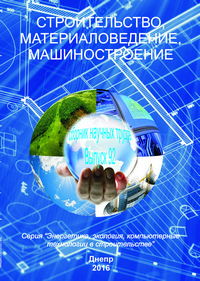Parametric identification of water heating systems for project management during operation
Keywords:
identification of hydraulic circuit, thermal mark, water heating system, flow meter, evolution algorithm, project managementAbstract
Abstract. Purpose. It is proposed to determine hydraulic parameters of water heating systems during operation to use identification of hydraulic circuit. The mathematical model of the hydraulic circuit is the model with concentrated parameters. The mane parameters of the hydraulic circuit are: flow rates at circuit jets, flow rates at circuit edges of the graph, pressure at circuit jets and difference pressure at circuit edges, hydraulic resistances of circuit edges. Identification of the hydraulic circuit is performed by the method of ―mathematical flowmeter‖. Methodology. There are measuring of some parameters of the circuit in the base of the method and comparison of calculated and experimental data. Experimental flow rates are determined by the mark method. Thermal mark is proposed for velocity marking at water heating systems. It is impossible to measure flow velocity at all edges of the graph. So problem identification of hydraulic circuit is not correctly formulated. It is necessary use additional criterion (stabilization) for the solving of not correctly identification. Findings. Two criterions were proposed for parameter identification of the circuit. First criterion is the difference between calculated and experimental flow rates. Second criterion is standard deviation from hydraulic resistances to the previously known values. The problem of parameter identification of water heating systems transform to problem of mathematical programming. The algorithm of evolutionary search is applied to solution the problem of identification with two criterions. Second criterion is transformed to constraint in the form of inequality. Originality. The algorithm of evolutionary search is applied to solution the identification problem with two criterions. The original algorithm deals with search of optimal solutions for binary choice relation. The following assumptions are made for choice relation. The choice relation is relation of non-strict order. The two functions enter the evolutionary algorithm, such as generation function and choice function Practical value. Generation function is the special procedure deals with scalar parameters (continuous or discrete). Some parallel evolutionary processes are fulfilled, which name the branches of evolution. After every step of iterate the parameters of the evolutionary search are calculated for another iterate step. There is convergence proof with probability 1 (almost sure convergence) for non-convex binary choice relations. Identification of hydraulic resistances of water heating systems during exploitation is proposed as a stage of project management.References
Evdokimov A.G. and Dubrovskiy V.V. Potokoraspredelenie v injenernih setyah [Flow in engineering networks]. Moscow, Stroyizdat Publ., 1987. 199 p. (in Russian).
Irodov V.F. and Kasin A.N. Identifikaciya gidravlicheskih soprotivleniy truboprovodnih setey metodom evolucionnogo programirovaniya [Identification of water supply systems hydraulic resistance by evolutionary programming method]. Izv. Vuzov. Neft I gas – Proc. Higher education. Oil and gas, 1982, no. 10, pp. 64–68. (in Russian).
Irodov V.F. and Barkovski A.M. Matematicheskoe obespechenie identificacii parametrov vodyanih system otopleniya v usloviyah ekspluatacii [Identification water heating parameters software under operating conditions]. Matematichne ta programne zabezpechennya intelektualnih system [Mathematical and software of intellectual systems]. Dnipropetrovsk, 2012, pp. 128–129. (in Russian).
Irodov V.F. O postroenii i skhodimosti algoritmov samoorganizatsii sluchaynogo poiska [The construction and convergence of random search algorithms for self-organization]. Avtomatyka – Automation, 1987, issue 4, pp. 34–43. (in Russian).
Kremlevskii P.P. Rashodomery i schetchiki veshestv [Flow meters and substances counters]. Kiev, Politehnika Publ., 2004. 412 p. (in Russian).
Merenkov A.P., Svetlov K.S. and Hasilev V.Ya. Metody i sredstva dlya upravleniya ekspluataciey i razvitiem truboprovodnih system [Methods and resources for operation controlling and developing of pipeline systems]. Oprimizaciya I upravlenie v bolshih systemah energetiki [Optimization and management of large-scale power systems], 1970, pp. 60–80. (in Russian).
Merenkov A.P. and Hasilev V.Ya. Teoriya hydravlicheskih cepey [Hydraulic circuit theory]. Moscow, Nauka Publ., 1985. 279 p. (in Russian).
Irodov V.F. The construction and convergence of evolutional algorithms of random search for self-organization. Sov. J. Autom. Inf. Sci. Publ., 1987, issue 20, No. 4, рр. 32-41. (in English).
Merenkov A.P., Novitsky N.N. and Sidler V.G. Direct and inverse problems of flow distribution in hydraulic. Soviet. Techno. Rev. Sec. Ai Energy Rev. Harwood Academic Publishes, U.S.A., 1994, issue 7, Part 4, pp. 33–95. (in English).
Downloads
Published
Issue
Section
License
Редакція Видання категорично засуджує прояви плагіату в статтях та вживає всіх можливих заходів для його недопущення. Плагіат розглядається як форма порушення авторських прав і наукової етики.
При виявлені у статті більш ніж 25% запозиченого тексту без відповідних посилань та використання лапок, стаття кваліфікується як така, що містить плагіат. У цьому випадку стаття більше не розглядається редакцією, а автор отримує перше попередження.
Автори, в статтях яких повторно виявлено плагіат, не зможуть публікуватися в усіх журналах Видавництва ДВНЗ «Придніпровська державна академія будівництва та архітектури».
Автори, які публікуються у цьому журналі, погоджуються з наступними умовами:
- Автори залишають за собою право на авторство своєї роботи та передають журналу право першої публікації цієї роботи на умовах ліцензії Creative Commons Attribution License, котра дозволяє іншим особам вільно розповсюджувати опубліковану роботу з обов'язковим посиланням на авторів оригінальної роботи та першу публікацію роботи у цьому журналі.
- Автори мають право укладати самостійні додаткові угоди щодо неексклюзивного розповсюдження роботи у тому вигляді, в якому вона була опублікована цим журналом (наприклад, розміщувати роботу в електронному сховищі установи або публікувати у складі монографії), за умови збереження посилання на першу публікацію роботи у цьому журналі.
- Політика журналу дозволяє і заохочує розміщення авторами в мережі Інтернет (наприклад, у сховищах установ або на особистих веб-сайтах) рукопису роботи, як до подання цього рукопису до редакції, так і під час його редакційного опрацювання, оскільки це сприяє виникненню продуктивної наукової дискусії та позитивно позначається на оперативності та динаміці цитування опублікованої роботи (див. The Effect of Open Access).

